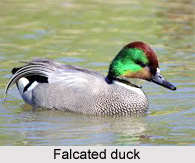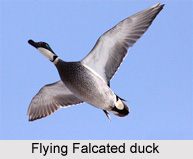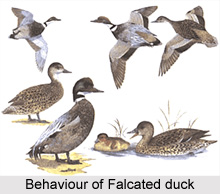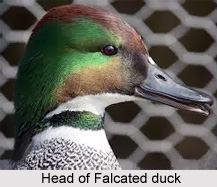 Falcated duck is or falcated teal is an Indian bird with a scientific name "Anas falcate" is a gadwall-sized dabbling duck. The closest relative of this species is the gadwall, followed by the wigeons.
Falcated duck is or falcated teal is an Indian bird with a scientific name "Anas falcate" is a gadwall-sized dabbling duck. The closest relative of this species is the gadwall, followed by the wigeons.
Behaviour of Falcated Duck
Falcated ducks have a very intricate courtship ritual. The females perform a series of inciting calls and other movements while preening behind the wings of their targeted male. Males use a courting method similar to others in the Anas genus, including an introductory shake, a neck-stretching burp call, a grunt whistle, and a head-up-tail-up display.
Mating Season of Falcated Duck
During the mating season falcated ducks form monogamous pairs that last throughout the mating season. It is currently not known how long the falcated duck lifespan is. There is also not much information on their territory size because these ducks are not studied as closely as other more popular species like swans or geese.

Character traits of Falcated Duck
Falcated ducks have found these "wild" hybrids in several instances over the past few years. These birds shared morphological traits with both species. Still, most of the traits favoured the falcated duck. It was reported that these hybrid birds have joined courting parties of Eurasian Widgeon and even attempted to compete with Widgeon males. Grunt-whistling, and burping calls being the method of inciting courtship, even resemble that of the falcated duck and not of the Eurasian wigeon. The hybrid bird, most closely watched, was quite sexually active however, it is not yet known if they can reproduce with either of the female species.
Hybridization of Falcated duck
Hybridization of the Falcated duck between two different species often leaves the offspring sterile, but this genus shows a surprising amount of hybrid fertility. This hybrid species performed courtship rituals more closely related to the falcated duck, yet socially was active in Eurasian Wigeon flocks. Successful reproduction was not seen between the hybrid species and a pure Eurasian Wigeon female during the fieldwork study. Further study of hybrid avian species can help shed light onto avian reproduction and their evolutionary biology.
Successful reproduction was not seen between the hybrid species and a pure Eurasian Wigeon female during the fieldwork study. Further study of hybrid avian species can help shed light onto avian reproduction and their evolutionary biology.
Concentration of Falcated duck
Falcated duck is a species of lowland wetlands, such as water meadows or lakes, and usually feeds by dabbling for plant food or grazing. Falcated duck nests on the ground, near water and under the cover of taller vegetation. The clutch is 6-10 eggs. Falcated duck breeds in eastern Asia. It nests in eastern Russia, in Khabarovsk, Primorskiy, Amur, Chita, Buryatia, Irkutsk, Tuva, eastern Krasnoyarsk, south central Sakha Sakhalin, extreme north eastern North Korea and northern China, in north eastern Inner Mongolia, and northern Heilongjiang, and in northern Japan, Hokkaido, Aomori, and the Kuril Islands. It is widely recorded well outside its normal range, but the popularity of this beautiful duck in captivity clouds the origins of these extra limital birds.
Migratory Falcated Duck
 Migratory Falcated ducks are strongly migratory and winters in much of Southeast Asia. In Indian states like-Uttar Pradesh, Bihar, Assam, eastern Haryana. Also in northern Bangladesh, northern and central Myanmar, northern Laos to the Mekong River, northern Vietnam (from about Hanoi north), and China: Hainan, Taiwan, Yunnan, Guangxi Zhuang, Guangdong, Fujian, Jiangxi, northern Hunan, Hubei, Zhejiang, Anhui, Jiangsu, Shandong, southern Hebei, Shanxi, northern Shaanxi. It is gregarious outside the breeding season and will then form large flocks. It is estimated that there are about 89,000 falcated ducks in total; this is much higher than the previous population estimate of 35,000 worldwide.
Migratory Falcated ducks are strongly migratory and winters in much of Southeast Asia. In Indian states like-Uttar Pradesh, Bihar, Assam, eastern Haryana. Also in northern Bangladesh, northern and central Myanmar, northern Laos to the Mekong River, northern Vietnam (from about Hanoi north), and China: Hainan, Taiwan, Yunnan, Guangxi Zhuang, Guangdong, Fujian, Jiangxi, northern Hunan, Hubei, Zhejiang, Anhui, Jiangsu, Shandong, southern Hebei, Shanxi, northern Shaanxi. It is gregarious outside the breeding season and will then form large flocks. It is estimated that there are about 89,000 falcated ducks in total; this is much higher than the previous population estimate of 35,000 worldwide.
Structure of Falcated Duck
The Males and females of Falcated duck have similar lengths at 46 to 53 cm. Their weight can range from 422 to 770 grams, with males weighing more than their female counterparts. Wingspans range from 79 to 91 cm. The breeding male is unmistakable. Most of the body plumage is finely vermiculated grey, with the long sickle-shaped tertials, which give this species its name, hanging off its back. The large head is dark green with a white throat, and a dark green collar and bronzed crown. The vent region is patterned in yellow, black and white. The female falcated duck is dark brown, with plumage much like a female wigeon. Its long grey bill is an aid to identification. The eclipse male is like the female, but darker on the back and head. In flight both sexes show a pale grey underwing. The blackish speculum is bordered with a white bar on its inner edge. Young birds are buffer than the female and have short trials. Juveniles have plumage similar to females of the species.











